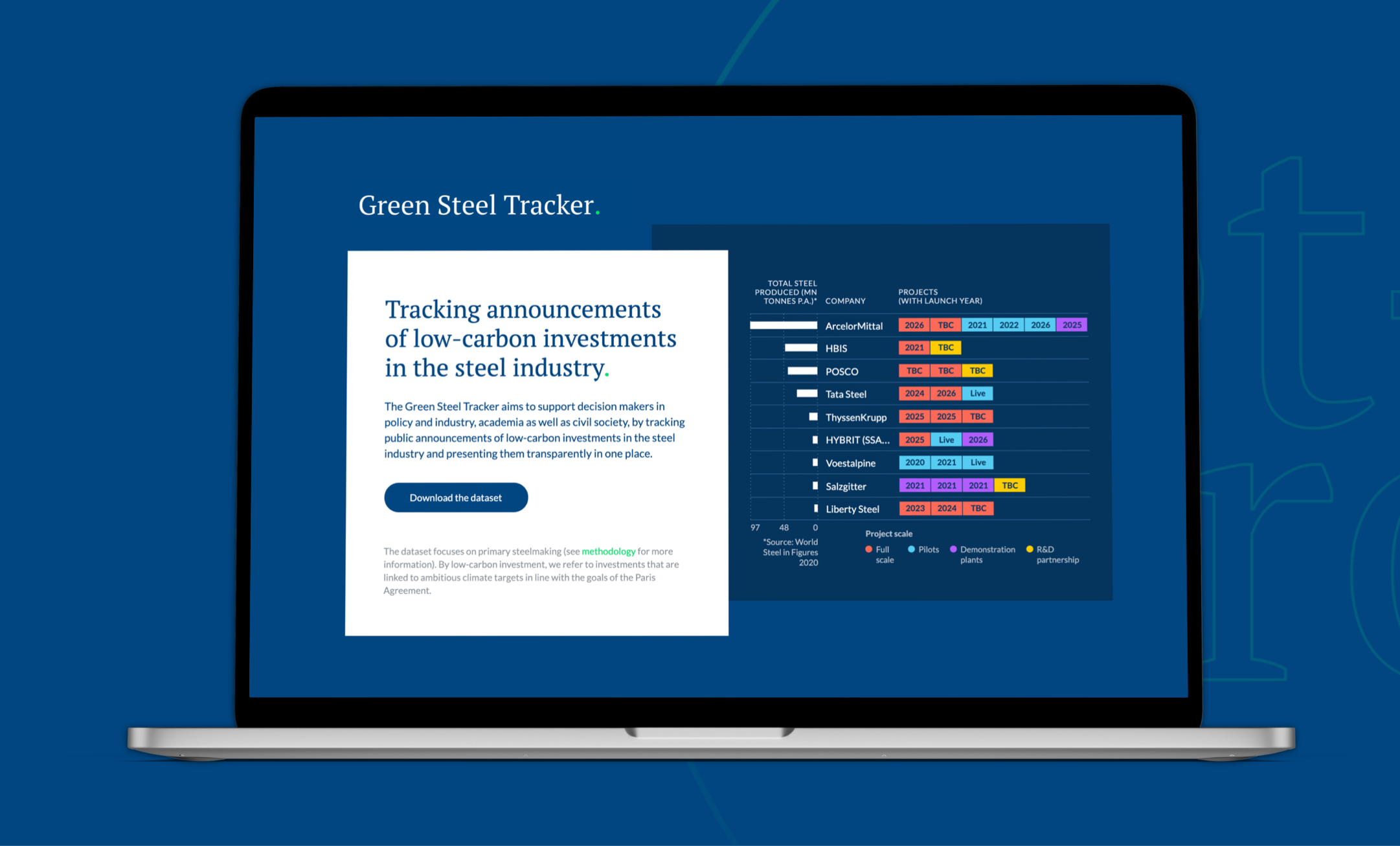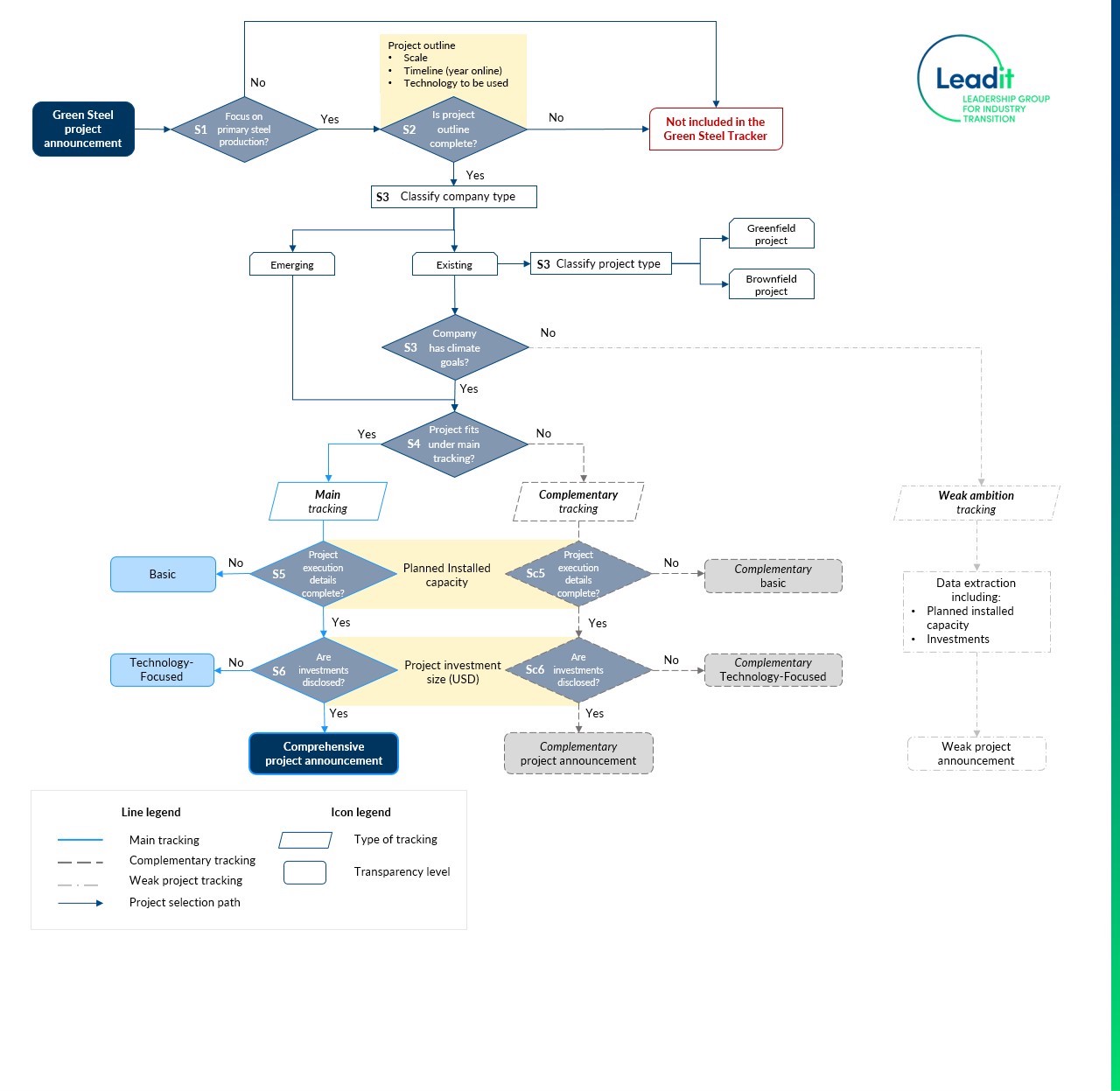Green Steel Tracker.
Methodology.
Authored by: Eileen Torres-Morales and Björn Nykvist
Reviewed by: Max Åhman and Jonas Algers (Lund University)
This new version of the methodology launched on 14 Nov 2023. The new methodology will be applied to the current data in early 2024. The older version is archived here for transparency.
More questions? Visit the Green Steel Tracker Q&A
LeadIT Green Steel Tracker Methodology
Read the full versionIntroduction
Emissions stemming from the steel sector contribute approximately 2.8 gigatonnes of CO2 annually, accounting for approximately 7% of the global CO2 emissions and approximately 5% of emissions within the European Union (European Commission, 2022; IEA, 2023). To align the iron and steel industry with the Paris Agreement objectives, a substantial reduction in carbon dioxide emissions is imperative.
The Green Steel Tracker developed by the Leadership Group for Industry Transition aims to provide support to decision makers in policy and industry, as well as to civil society, by gathering all information on low-carbon investments in the steel industry in one place. The tracker monitors the progress of initiatives utilizing technologies able to minimize carbon dioxide emissions, framed under a time-bound company-wide plan for decreasing iron and steel carbon dioxide emissions.
This methodology presented is an iteration of a previous version of the Green Steel Tracker methodology, with the vision of fulfilling the demand for detailed and transparent information on low-carbon iron and steel production.

Objective
The aim of the Green Steel Tacker updated methodology is to provide a comprehensive classification by how much transparency is provided in the announced low-carbon initiatives within the primary steel sector and also to showcase the climate commitments of the leaders in steel production. Therefore, the tracker has two core objectives. First, it systematically presents and classifies low-carbon project announcements in the primary steel sector. Second, it displays the climate pledges of the leading steel manufacturers, with goals short-term goals to 2030 and long-term goals to 2050.
By adhering to this two-stage framework, the tracker aims to provide an inclusive and comprehensive repository with the highest degree of transparency.
Scope
The tracker consolidates and classifies low-carbon projects in the primary steel sector. Projects are differentiated depending on the technology and categorized by their transparency level. Three project tracking categories are used according to the technology employed: main, complementary, and weak ambition.
- Projects included in main tracking refer to iron and steel projects using renewable energy and renewable-sourced hydrogen. This includes primary steel production technology using renewable electricity directly and includes but is not limited to, molten oxide electrolysis (MOE), electrowinning and electric smelting reduction (ESR). It also includes primary steel production using hydrogen direct reduction (H-DRI) projects when using renewable sourced hydrogen—commonly known as green hydrogen—for the reduction of iron ore.
- Complementary tracking considers the announcements of certain Carbon Capture and Storage (CCS) projects, and the production of green hydrogen associated with steel plants and as well as the utilization of biomass-derived substitutes for conventional coal and coke, such as biochar. An example of hydrogen production could be the announcement of the production of green hydrogen in collaboration with other partners, without explicitly specifying the use of said hydrogen in the steel production process.
Projects that depend exclusively on CCS, without replacing the blast furnace-basic oxygen furnace (BF-BOF) setup are subjected to thorough evaluation. This includes the climate commitments of the steel producer, clarity on how to achieve high mitigation levels with complementary biomass, and the timeline and status of applying CCS. Announcements of projects employing biomass-based energy sources, specifically biochar (also referred to as bio-charcoal) are also included in the complementary scope. However, such project announcements are only included if the biomass source is transparently articulated, and its sustainable sourcing is verified.
- If the company does not have ambitious goals, ideally Paris Agreement aligned, the project is assessed separately under the weak ambition category.
Second, project announcement transparency level is assessed as basic, technology-focused and, depending on the type of technology, as a comprehensive or complementary project announcement.
The following flowchart presents the systematic process to classify the project announcements by technology (considering company-level climate commitments) and the possible transparency levels. For more details on the selection please consult the methodology documentation.

Sources
In the early stages of the tracker, data collection was the result of the collective efforts of several research groups, while subsequent data collection has been led by LeadIT. The Green Steel Tracker is based on online resources such as official project announcements, industry reports, relevant media outlets, and relevant and trustworthy publications. The URLs to each source can be obtained from the tracker database.
Validation
The methodology and dataset are reviewed by experts within the field of steel decarbonisation who review the dataset before publication. Experts at Lund University, Sweden, conduct an evaluation of project alignment to the tracker methodology.
All project the information collected in the tracker has been published in publicly accessible material. Confidential information is not included in data collection nor included in the tracker. If projects involve collaborations, research and development partnerships, or joint ventures, the nature of these collaborations is verified in more than one source.
Data validation is a continuous process. As new information becomes available, existing project details are gathered and reviewed. General updates of the tracker and dataset are uploaded at least once every six months.
Sources of uncertainties
Confidential projects and information not publicly disclosed are not tracked and no data of this type is gathered. Therefore, projects could be overlooked if no public announcements are made.
Companies are encouraged to get in touch with The Secretariat if a recently announced project is not considered in the tracker. The Secretariat will verify that the announcement information is public and feed it to the tracker.
Language is a barrier and could hinder or prevent the identification of projects with language different from Swedish, English, and Spanish.
Citation
The dataset might be used by others under a CC BY license. It should be cited as: Green Steel Tracker (2024) Leadership Group for Industry Transition. Available at: www.industrytransition.org/green-steel-tracker/
LeadIT thanks all the researchers who have worked on the development of the tracker including: Vogl, V; Torres Morales, E; Sanchez, F; Gerres, T; Lettow, F; Bhaskar, A; Swalec, C; Mete, G; Åhman, M; Lehne, J; Schenk, S; Witecka, W; Olsson, O; Rootzén, J.
References
European Commission, 2022. EU climate targets: how to decarbonise the steel industry [WWW Document]. URL https://joint-research-centre.ec.europa.eu/jrc-news/eu-climate-targets-how-decarbonise-steel-industry-2022-06-15_en (accessed 4.19.23).
IEA, 2023. Emissions Measurement and Data Collection for a Net Zero Steel Industry.
More questions? Visit the Green Steel Tracker Q&A
